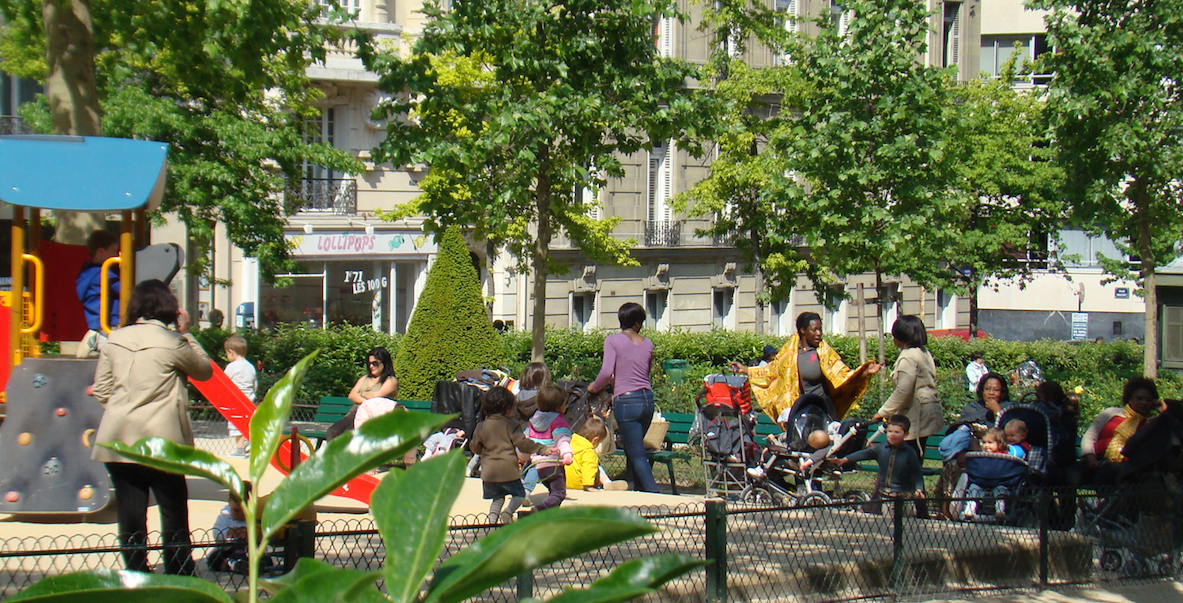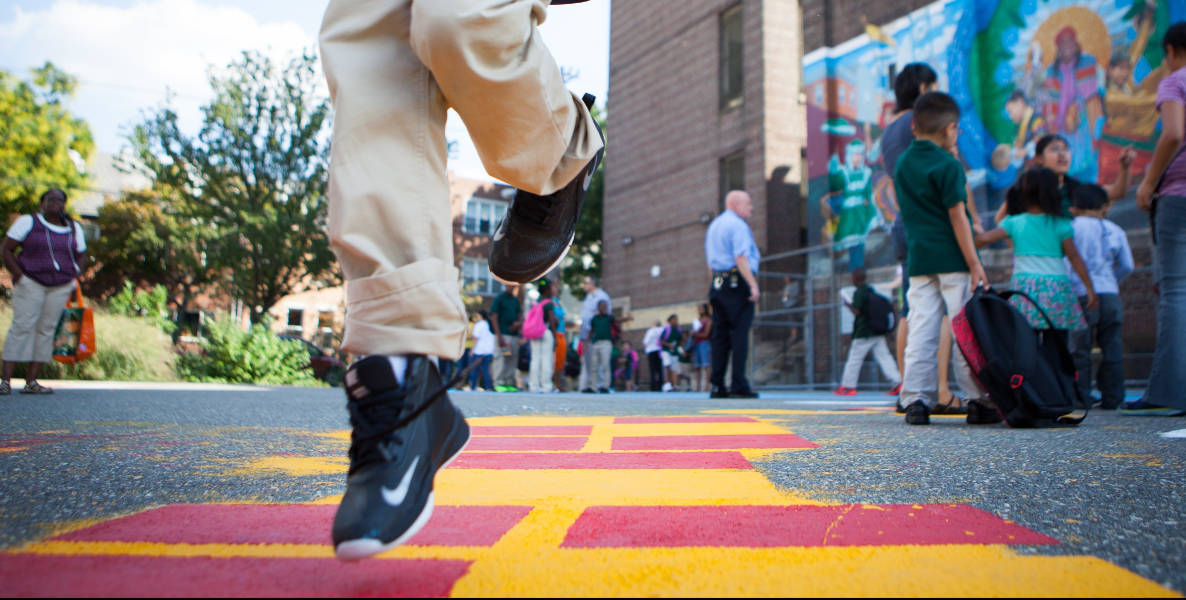Bet you anything I know something that most Philadelphia public school students won’t remember from their childhood: verdant, gorgeous and green playgrounds. Now, granted, it’s unlikely that any city kid remembers their recess blacktop featuring butterfly bushes and trees—but isn’t that kind of sad? Suburban kids get to grow up ensconced by nature (hayseed that I am, my childhood schoolyard was about 15 acres of trees and bounding fields). But in metropolitan areas, students typically only get to spend their precious recess hour on the blacktop.
Be Part of the Solution
Become a Citizen member.Until recently, that is. In the past few years, cities across the country have moved toward greening schoolyards, not just for the sake of their playtime, but also for the sake of their education. Green Schoolyards America, a program managed by the Earth Island Initiative non-profit, has done great work converting west coast public parks and schoolyards into veritable interactive gardens.
In Denver, CO, for example, a major push led by The Big Sandbox has led to nearly 100 Denver public schoolyards undergoing improvements that incorporate trees and flowers into their layout. Boston has completed a city-wide redesign of every public school playground in the city, and there have been similar initiatives in Houston and Chicago.
And for good reason. In 2014, it was reported by CU Boulder Today that a study found that students of a Baltimore private school whose schoolyard had undergone a radical green redesign had large drops in their daily stress levels—something even more important to urban school kids who often arrive at school carrying a lot of stress.
In Philadelphia, the School District is undertaking one of the biggest school greening efforts in the nation that goes well beyond playgrounds. Under a program called GreenFutures, Philadelphia is currently installing green schoolyards at 13 of the city’s 218 public schools, with the intention of ultimately installing five per year.
But more fundamentally, GreenFutures is about making Philadelphia’s public schools—and the city at large—more environmentally friendly, from the ground up. GreenFutures delineates 65 discreet actions the district plans to take by 2020 in five different areas—efficiencies, engagement, equity, environment and education. The actions range from greening schoolyards and decreasing energy use to improving transportation, facilities and fitness.
Environmental health touches everything—the state of school buildings, the physical and emotional health of students, their ability to thrive and survive in the future. Is there a more important area to focus on?
In August, the District won a 2017 U.S. Department of Education Green Ribbon, an environmental award, for its GreenFutures plan.
GreenFutures’ larger mission is to completely change the way kids learn about the environment, making environmental consciousness a cornerstone of public education.So far, 19 Philadelphia schools have registered as “Eco-Schools” with GreenFutures. Those schools will integrate certain ecological and environmental practices into their curriculum, including climate change education and biological investigation—you know, the fun part of middle school science where the teacher takes the class into nature to hunt for local flora and fauna. The program also calls for an overhaul of how the schools themselves manage their waste, recycling and energy efficiency programs.
Sharon Jaye, executive director of the Green Schools Alliance, a national coalition of schools committed to green energy solutions, says Philadelphia’s efforts are not the first in the country, and they are not as widespread as extremely green school districts like Houston or Boulder.
![]()
But Jaye says GreenFutures has something that many other districts its size don’t: A formal plan with specific goals. Take New York City, for example. New York, says Jaye, may have more green programs distributed across its school district. But they are enacted haphazardly, on a school by school basis, which makes it difficult to track how well the district does overall in conserving energy or meeting green standards. Philadelphia’s model allows for accountability and direction, which Jaye says are more likely to lead to success.
“A lot of school districts have made great strides, but they haven’t actually formalized it,” Jaye says. “The way Philadelphia is doing it is actually pretty smart, because they have something to back up the decisions that they’re making. And if someone balks at it, they can just say that they’re trying to satisfy the city and school district’s sustainability plan.”
All things considered, according to Jaye, things are progressing nicely in Philadelphia.
“I think (the Philadelphia School District) is doing a great job,” she says. “It’s easier to get things going if you’ve done the planning work ahead of time. And that’s how Philadelphia’s doing it.”
GreenFutures is the brainchild of Francine Locke, environmental director of the Philadelphia School District. About five years ago, Locke was at a week-long environmental health leadership professional development program at Harvard, when a discussion about “sustainability” led her to a realization about her job.
“We discussed how sustainability comes from the environmental department, and how “environmental” touches every other department,” Locke says. “That’s when I began building the framework for GreenFutures.”
![]()
Locke’s goal was to create an all-encompassing environmental sustainability program for the school district—something of a mammoth task. It took her two years to finish drafting the program, and plenty of chatting with the biggest environmental bigwigs in the city, including Catherine Gajewski, the former sustainability director for the city of Philadelphia, and Alex Dews, who formerly worked for Greenworks Philadelphia and is currently the executive director of the Delaware Valley Green Building Council. Locke and her colleagues studied the green schools movements across the country, from Colorado to New York, and met with sustainability directors from the Green Schools Alliance, which Philadelphia has since joined.
“They connected us to amazing people who were experts in fields of sustainability from green infrastructure and outdoor spaces to energy and recycling,” says Locke. “And they connected us with a ton of funders, and that really helped us to flesh out our focus areas.”
Locke says Philly actually had something of a leg up when it came to instituting its ambitious green rebuild: some of the arms of the program were in place before GreenFutures launched.
“There was a ton of work going in the school district that just wasn’t part of a plan,” she says. “For example, our procurement director, at the time, was procuring these ways to save energy, and saving a lot of money with innovation in that area. Schools were building their schoolyards. The capital program was already building stormwater infrastructure and outdoor educational spaces through grants from the Philadelphia Water Department. A lot of the pieces were there—it was just a matter of coordinating those things.”
Prior to the implementation of GreenFutures, the school district had also started Harvest of the Month, a program that provided Philly school kids new fresh fruits and vegetables every month.
According to Locke, these sustainability efforts were actually the cornerstone of the GreenFutures pitch: The school district had already assembled significant amount of green programming; GreenFutures was the program that would house them all, and add a few more to the mix—specifically setting sustainability goals for the district, formalizing the Green Schoolyards program and codifying a change in how ecological and environmental sciences are taught in Philly so they are front and center, with more hands-on experimentation and student interaction.
“Children learn best in green schools that are healthy, that have outdoor educational spaces, that have a thoughtful way of looking at waste and energy efficiency. Children should be in a nurturing environment, with the community and school embracing the whole philosophy of being sustainable,” says Megan Garner, sustainability director for the Philadelphia School District. “Every school a green school. That’s the ultimate goal.”
“Children learn best in green schools that are healthy, that have outdoor educational spaces, that have a thoughtful way of looking at waste and energy efficiency,” says Megan Garner, sustainability director for the Philadelphia School District. “Every school a green school. That’s the ultimate goal.”
The program is, undoubtedly, a big undertaking. And it is the kind of project that might cause some education advocates to shake their heads, wondering how the School District can make a major commitment of focus and manpower to an issue that can seem trivial in comparison to the enormous problems facing Philadelphia public schools. But environmental health touches everything—the state of school buildings, the physical and emotional health of students, their ability to thrive and survive in the future. Is there a more important area to focus on?
In fact, the folks at GreenFutures tout their project as a beneficial, cost-cutting measure. Locke says the program is almost entirely grant-funded, with long-term commitments from a variety of funding partners, including the U.S. Environmental Protection Agency, the Pennsylvania Horticultural Society and The Land Health Institute. The Philadelphia School District’s annual utility budget is roughly $45 million; GreenFutures aims to make a huge dent in that expense by having students help perform energy audits of their school buildings, calculating gas and electrical expenditures and ways to save.
![]() Already, the program is showing some success. Hydration stations—renovated water fountains designed to fill reusable bottles—have been installed in about 40 Philly schools as part of GreenFutures, saving over a million plastic bottles in the last year. According to a GreenFutures report, students at five schools participated in its initial energy audit program, resulting in savings of $1.5 million. And an audit of utility billing found over $2.4 million in additional savings.
Already, the program is showing some success. Hydration stations—renovated water fountains designed to fill reusable bottles—have been installed in about 40 Philly schools as part of GreenFutures, saving over a million plastic bottles in the last year. According to a GreenFutures report, students at five schools participated in its initial energy audit program, resulting in savings of $1.5 million. And an audit of utility billing found over $2.4 million in additional savings.
Philadelphia public schools are not often something to brag about nationally. But if the commitment to GreenFutures holds—and it’s a big if, considering the fluid, fickle nature of educational politics in Philly—our city could become a national leader in at least one aspect of schooling: Urban environmental education.
Header Photo: David Nicholson



